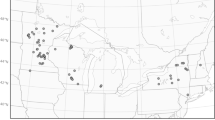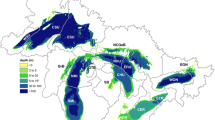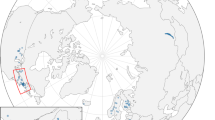Abstract
Ecosystems in biogeographical transition zones, or ecotones, tend to be highly sensitive to climate and can provide early indications of future change. To evaluate recent climatic changes and their impacts in a boreal-temperate ecotone in eastern North America, we analyzed ice phenology records (1975–2007) for five lakes in the Adirondack Mountains of northern New York State. We observed rapidly decreasing trends of up to 21 days less ice cover, mostly due to later freeze-up and partially due to earlier break-up. To evaluate the local drivers of these lake ice changes, we modeled ice phenology based on local climate data, derived climatic predictors from the models, and evaluated trends in those predictors to determine which were responsible for observed changes in lake ice. November and December temperature and snow depth consistently predicted ice-in, and recent trends of warming and decreasing snow during these months were consistent with later ice formation. March and April temperature and snow depth consistently predicted ice-out, but the absence of trends in snow depth during these months, despite concurrent warming, resulted in much weaker trends for ice-out. Recent rates of warming in the Adirondacks are among the highest regionally, although with a different seasonality of changes (early winter > late winter) that is consistent with other lake ice records in the surrounding area. Projected future declines in snow cover could create positive feedbacks and accelerate current rates of ice loss due to warming. Climate sensitivity was greatest for the larger lakes in our study, including Wolf Lake, considered one of the most ecologically intact ‘wilderness lakes’ in eastern North America. Our study provides further evidence of climate sensitivity of the boreal-temperate ecotone of eastern North America and points to emergent conservation challenges posed by climate change in legally protected yet vulnerable landscapes like the Adirondack Park.





Similar content being viewed by others
References
Aber JD, Driscoll CT (1997) Effects of land use, climate variation, and N deposition on N cycling and C storage in northern hardwood forests. Glob Biogeochemical Cycles 11(4):639–648
Adrian R, Wilhelm S, Gerten D (2006) Life-history traits of lake plankton species may govern their phenological response to climate warming. Glob Change Biol 12(4):652–661
Adrian R, O'Reilly CM, Zagarese H et al (2009) Lakes as sentinels of climate change. Limnol Oceanog 54:2283–2297
Allen CD, Breshears DD (1998) Drought-induced shift of a forest-woodland ecotone: rapid landscape response to climate variation. Proc Natl Acad Sci USA 95:14839–14842
Arseneau KMA, Driscoll CT, Brager LM, Ross KA, Cumming BF (2011) Recent evidence of biological recovery from acidification in the Adirondacks (NY, USA): a multiproxy paleolimnological study of Big Moose Lake. Can J Fish Aq Sci 68(4):575–592
Assel RA, Robertson DM (1995) Changes in winter air temperatures near Lake Michigan, 1851-1993, as determined from regional lake-ice records. Limnol Oceanog 40(1):165–176
Beckage B, Osborne B, Gavin DG, Pucko C, Siccama T, Perkins T (2008) A rapid upward shift of a forest ecotone during 40 years of warming in the Green Mountains of Vermont. Proc Natl Acad Sci USA 105(11):4197–4202
Blenckner T, Olmstedt A, Rummukainen M (2002) A Swedish case study of contemporary and possible future consequences of climate change on lake function. Aquat Sci 64:171–184
Bradley NL, Leopold AC, Ross J, Huffaker W (1999) Phenological changes reflect climate change in Wisconsin. Proc Nat Acad Sci USA 96:9701–9704
Burnham KP, Anderson DR (2002) Model selection and multimodel inference: a practical information-theoretic approach, 2nd edn. Springer, New York, New York, USA, p 488
Campbell J, Mitchell MJ, Mayer B (2006) Isotopic assessment of NO -3 and SO 2-4 mobility during winter in two adjacent watersheds in the Adirondack Mountains, New York. J. Geophys. Res. 111 doi:10.1029/2006JG000208
Charles DF, Binford MW, Furlong ET et al (1990) Paleoecological investigation of recent lake acidification in the Adirondack Mountains, N.Y. J. Paleolimnology 3:195–241
R Development Core Team (2008) R: A language and environment for statistical computing. R Foundation for Statistical Computing, Vienna, Austria. http://www.R-project.org
Fang X, Stefan HG (1998) Potential climate warming effects on ice covers of small lakes in the contiguous U.S. Cold Regions Sci Tech 27:119–140
Fritts HC (1971) Dendroclimatology and dendroecology. Quaternary Research 1:419–49
Frumhoff PC, McCarthy JJ, Melillo JM, Moser SC, Wuebbles DJ (2007) Confronting climate change in the U.S. Northeast: Science, Impacts and Solutions. Synthesis report of the Northeast Climate Impacts Assessment (NECIA). Union of Concerned Scientists, Cambridge, MA
Hamburg SP, Cogbill CV (1988) Historical decline of red spruce populations and climatic warming. Nature 331:428–431
Hayhoe K, Wake CP, Huntington TG et al (2007a) Past and future changes in climate and hydrological indicators in the US Northeast. Clim Dyn 28:381–407
Hayhoe K, Wake C, Anderson B et al (2007b) Regional climate change projections for the Northeast USA. Mitig Adapt Strat Glob Change. doi:10.1007/s11027-007-9133-2
Hodgkins GA, James IC, Huntington TG (2002) Historical changes in lake ice-out dates as indicators of climate change in New England. Int J Climatol 22:1819–1827
Huntington TG (2003) Climate warming could reduce runoff significantly in New England. USA Agric Forest Meteor 117:193–201
Huntington TG, Richardson AD, McGuire KJ, Hayhoe K (2009) Climate and hydrological changes in the northeastern United States: recent trends and implications for forested and aquatic ecosystems. Can J For Res 39:199–212
Iverson LR, Prasad AM (2002) Potential redistribution of tree species habitat under five climate change scenarios in the eastern US. For Ecol Mgmt 155:205–222
Jenkins J, Keal A (2004) The Adirondack atlas: a geographic portrait of the Adirondack Park. Wildlife Conservation Society, New York, p 275
Jensen OP, Benson BJ, Magnuson JJ, Card VM, Futter MN, Soranno PA, Stewart KM (2007) Spatial analysis of ice phenology trends across the Laurentian Great Lakes region during a recent warming period. Limnol Oceanogr 52(5):2013–2026
Keller W (2007) Implications of climate warming for Boreal Shield lakes: a review and synthesis. Environ Rev 15:99–112
Kendall M (1938) A new measure of rank correlation. Biometrika 30:81–89
Koinig KA, Schmidt R, Sommaruga-Wograth S, Tessadri R, Senner RP (1998) Climate change as the primary cause for pH shifts in a high alpine lake. Water Air Soil Pollut 104:167–180
Kupfer JA, Cairns DM (1996) The suitability of montane ecotones as indicators of global climatic change. Prog Phys Geogr 20:253–267
Latifovic R, Pouliot D (2007) Analysis of climate change impacts on lake ice phenology in Canada using the historical satellite data record. Remote Sens Envir 106:492–507
Leopold DJ, Reschke C, Smith DS (1988) Old-growth forests of Adirondack Park, New York. Nat Area J 8:166–189
Livingstone DM (1997) Break-up dates of alpine lakes as proxy data for local and regional mean surface air temperatures. Clim Change 37:407–439
Maguson JJ, Robertson DM, Benson BJ et al (2000) Historical trends in lake and river ice cover in the northern hemisphere. Science 289:1743–1746
Mahmood R, Foster SA, Logan D (2006) The GeoProfile metadata, exposure of instruments, and measurement bias in climatic record revisited. Int J Climatol 26:1091–1124
Mann HB (1945) Nonparametric tests against trend. Econometrica 13:245–259
McCarty JP (2002) Ecological consequences of recent climate change. Cons Bio 15(2):320–331
McMichael A, Campbell-Lendrum D, Corvalan C, Ebi K, Githeko A, Scheraga J, Woodward A (2003) Climate change and human health: risks and responses. World Health Organization, Geneva, p 322
Mitchell MJ, Driscoll CT, Murdoch P, Likens GE, Kahl JS, Pardo L (1996) Climatic control of nitrate loss from forested watersheds in the northeast United States. Env Sci Tech 30:2609–2612
Neilson RP (1993) Transient ecotone response to climatic change: some conceptual and modelling approaches. Ecol Appl 3(3):385–395
Ollinger SV, Goodale CL, Hayhoe K, Jenkins JP (2007) Potential effects of climate change and rising CO2 on ecosystem processes in northeastern U.S. forests. Mitig Adapt Strat Glob Change. doi:10.1007/s11027-007-9128-z
Paradis A, Elkington J, Hayhoe K, Buonaccorsi J (2007) Role of winter temperature and climate change on the survival and future range expansion of the hemlock woold adelgid (Adelges tsugae) in eastern North America. Mitig Adapt Strat Glob Change. doi:10.1007/s11027-007-9127-0
Park J, Mitchell MJ, McHale PJ, Christopher SF, Myers TP (2003) Interactive effects of changing climate and atmospheric deposition on N and S biogeochemistry in a forested watershed of the Adirondack Mountains, New York State. Glob Chg Biol 9:1602–1619
Parmesan C, Yohe G (2002) A globally coherent fingerprint of climate change impacts across natural systems. Nature 421:37–42
Parmesan C, Gaines S, Gonzalez L, Kaufman DM, Kingsolver J, Peterson AT, Sagarin JR (2005) Empirical perspectives on species borders: from traditional biogeography to global change. Oikos 108:58–75
Paterson AM, Cumming BF, Smol JP, Hall RI (2004) Marked recent increases of colonial scaled chrysophytes in boreal lakes: implications for the management of taste and odour events. Freshwater Biol 49(2):199–207
Paterson AM, Winter JG, Nicholls KH, Clark BJ, Ramcharan CW, Yan ND, Somers KH (2008) Long-term changes in phytoplankton composition in seven Canadian Shied lakes in response to multiple anthropogenic stressors. Can J Fish Aquat Sci 65(5):846–861
Pielke RA, Stohlgren T, Schell L et al (2002) Problems in evaluating regional and local trends in temperature: an example from eastern Colorado, USA. Int J Climatol 22:421–434
Robertson DM, Ragotzkie RA, Magnuson JJ (1992) Lake ice records used to detect historical and future climatic changes. Clim Change 21:407–427
Rosenzweig C, Casassa G, Karoly DJ et al (2007) In: Parry ML, Canziani OF, Palutikof JP, van der Linden PJ, Hanson CE (eds) Assessment of Observed Changes and Responses in Natural and Managed Systems. Climate Change 2007: Impacts, Adaptation and Vulnerability. Contribution of Working Group II to the Fourth Assessment Report of the Intergovernmental Panel on Climate Change. Cambridge University Press, Cambridge, pp 79–131
Rühland K, Paterson AM, Smol JP (2008) Hemispheric-scale patterns of climate-related shifts in planktonic diatoms from North American and European lakes. Glob Change Biol 14(11):2740–2754
Sen PK (1968) Estimates of the regression coefficient based on Kendall's tau. J Am Stat Assoc 63:1379–1389
Smol JP, Wolfe AP, Birks JB et al (2005) Climate-driven regime shifts in the biological communities of arctic lakes. Proc Nat Acad Sci USA 102(12):4307–4402
Stager JC, Sanger T (2003) An Adirondack “Heritage Lake”. Adirondack J Envir Stud 10:6–10
Stager JC, McNulty SA, Beier CM, Chiaranzelli J (2009) Historical patterns and effects of changes in Adirondack climates since the early 20th century. Adirondack J Envir Stud 15(2):22–38
Stefan HG, Fang X (1997) Simulated climate change effects on ice and snow covers on lakes in a temperate region. Cold Regions Sci Tech 25:137–152
Stefan HG, Fang X, Eaton JG (2001) Simulated fish habitat changes in North American lakes in response to projected climate warming. Trans Am Fish Soc 130:459–477
Sullivan TJ, Charles DF, Berner JA, McMartin B, Vache KB, Zehr J (1999) Relationship between landscape characteristics, history, and lakewater acidification in the Adirondack Mountains, New York. Water Air Soil Pollut 112:407–427
Treyger AL, Nowak CA (2011) Changes in tree sapling composition within powerline corridors appear to be consistent with climatic change in New York. Glob. Change Biol. (in press)
Vavrus SJ, Wynne RH, Foley JA (1996) Measuring the sensitivity of southern Wisconsin lake ice to climate variations and lake depth using a numerical model. Limnol Oceanog 41(5):822–831
Vincent WF (2009) Effects of climate change on lakes. In: Links GE (ed) Encyclopedia of Inland Waters Vol. 3. Elsevier, Oxford, pp 55–60
Weyhenmeyer GA, Meili M, Livingstone DM (2004) Nonlinear temperature response of lake ice breakup. Geophys Res Lett 31:1–4
Wilcox RR (2001) Theil-Sen estimator. In: Fundamentals of modern statistical methods. New York: Springer-Verlag. pp. 207–210
Williams G, Layman KL, Stefan HG (2004) Dependence of lake ice covers on climatic, geographic and bathymetric variables 40:145–164
Winder M, Schindler DE (2004) Climate change uncouples trophic interactions in an aquatic ecosystem. Ecology 85(8):2100–2106
Acknowledgements
We are grateful to the many individuals responsible for the lake phenology and climatological datasets at SUNY ESF’s Huntington Wildlife Forest, most notably O. Oja, R. Masters, C. Demers, R. Sage, and M. Mitchell as part of the Adirondack Long-Term Monitoring Program (ALTEMP) at the Adirondack Ecological Center. We also thank K. Arseneau, D. Bishop, J. Wiley, A. Fenton and C. Cummings for their assistance with data analysis and manuscript preparation, and J. Campbell for providing the corrected HWF weather record.
Author information
Authors and Affiliations
Corresponding author
Rights and permissions
About this article
Cite this article
Beier, C.M., Stella, J.C., Dovčiak, M. et al. Local climatic drivers of changes in phenology at a boreal-temperate ecotone in eastern North America. Climatic Change 115, 399–417 (2012). https://doi.org/10.1007/s10584-012-0455-z
Received:
Accepted:
Published:
Issue Date:
DOI: https://doi.org/10.1007/s10584-012-0455-z




